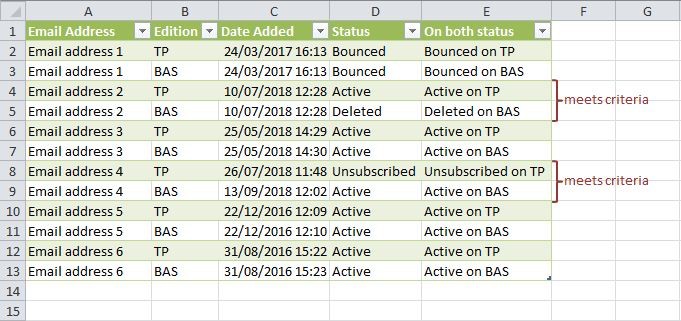Comparing rows in Excel to identify differences is a common task, especially when dealing with large datasets. This article focuses on a specific scenario: comparing two consecutive rows with email addresses and unique status values to determine if the first word of their status values differs. We’ll explore efficient techniques to achieve this in Excel, utilizing formulas and functionalities to streamline the process.
Identifying Email Addresses with Differing Status Prefixes
The core problem involves analyzing a dataset where each email address spans two rows, each with a unique three-word status value in a specific column (e.g., Column E). The goal is to pinpoint email addresses where the first word of these status values doesn’t match. For instance, if one row has “Active on TP” and the next has “Bounced on BAS”, the email address associated with these rows meets the criteria.
 Example of Excel data with highlighted rows that meet the criteria of differing status prefixes.
Example of Excel data with highlighted rows that meet the criteria of differing status prefixes.
Leveraging Excel Formulas for Comparison
Instead of manual inspection or complex workarounds, Excel formulas offer a powerful solution. The following approach combines several functions to achieve the desired outcome:
-
Extract the First Word: In a new helper column (e.g., Column F), extract the first word of the status value using the
LEFTandFINDfunctions. This formula in cell F2 would extract the first word from cell E2:=LEFT(E2,FIND(" ",E2)-1) -
Compare Consecutive Rows: In another helper column (e.g., Column G), compare the extracted first words from consecutive rows. Enter this formula in cell G3 and drag it down:
=IF(F2=F3,"Match","Mismatch")This formula compares the first word in the current row (F3) with the first word in the previous row (F2).
-
Filter for Mismatches: Now, you can easily filter Column G for “Mismatch” to identify the email addresses meeting your criteria. Since each email address occupies two rows, you’ll see “Mismatch” next to the second row of each matching email address. You can then filter Column A to only show unique email addresses associated with the mismatched status prefixes.
Alternative Approaches and Considerations
While the above method provides a robust solution, other approaches exist:
- Conditional Formatting: Highlight rows where the “Mismatch” value appears in Column G. This provides a visual cue without filtering.
- Advanced Filter: Utilize Excel’s Advanced Filter to extract the rows with “Mismatch” to a new location. This creates a separate list of the desired email addresses.
Remember to adapt these formulas and methods to your specific spreadsheet structure, including column names and row numbers. This solution avoids complex data manipulation and provides a scalable way to compare rows and identify discrepancies in your Excel data.